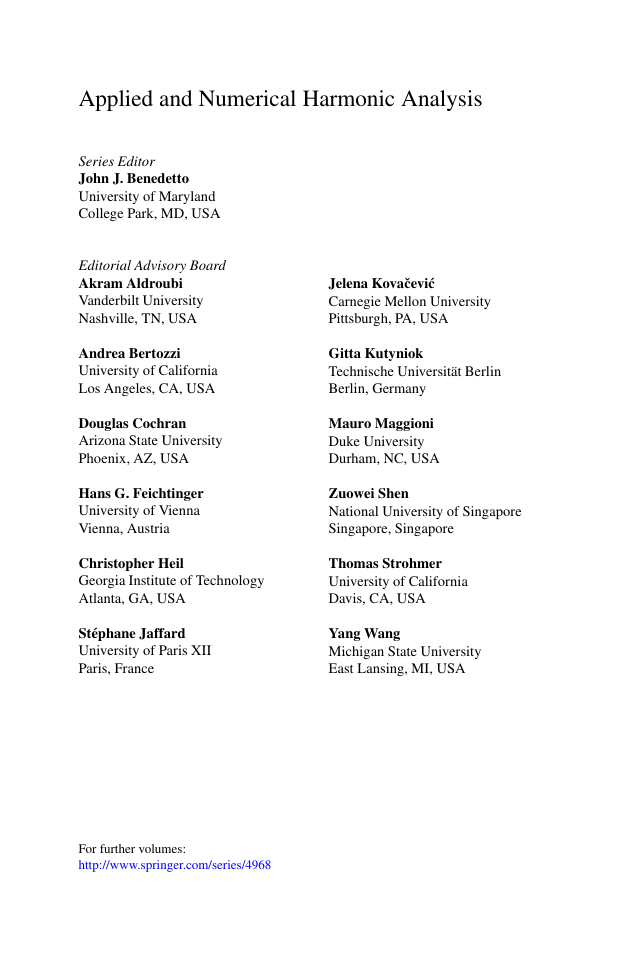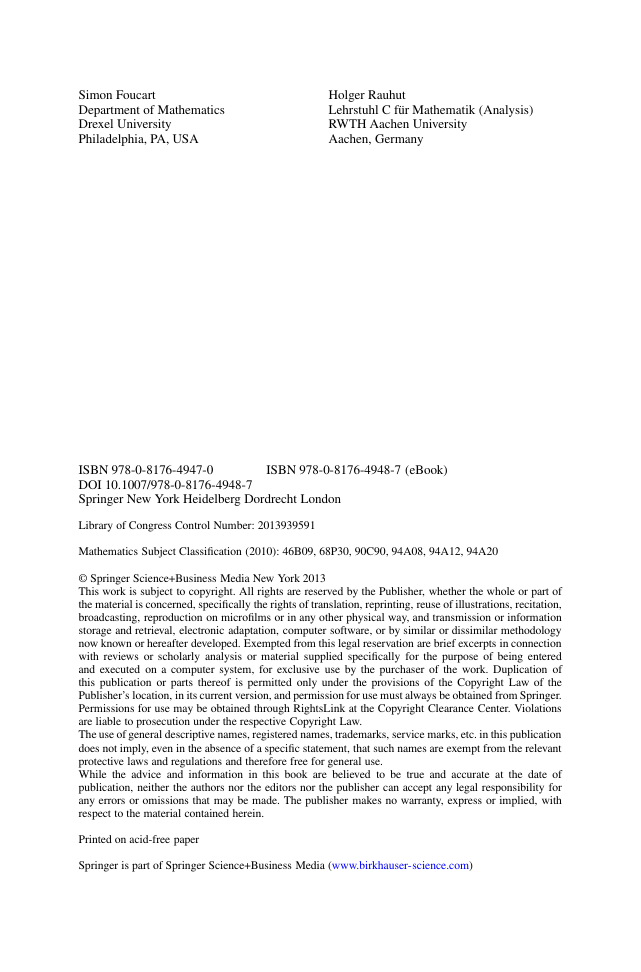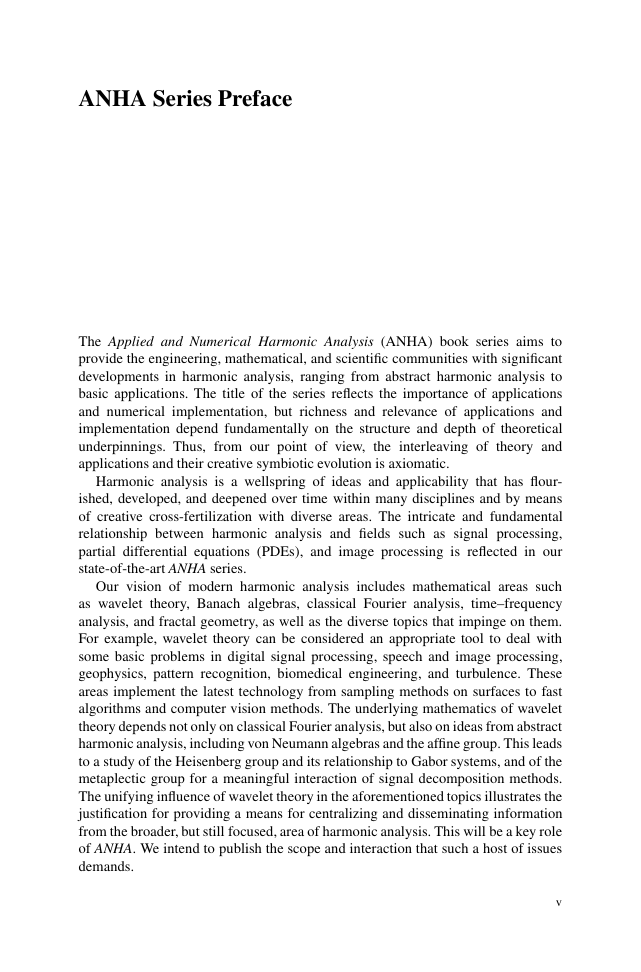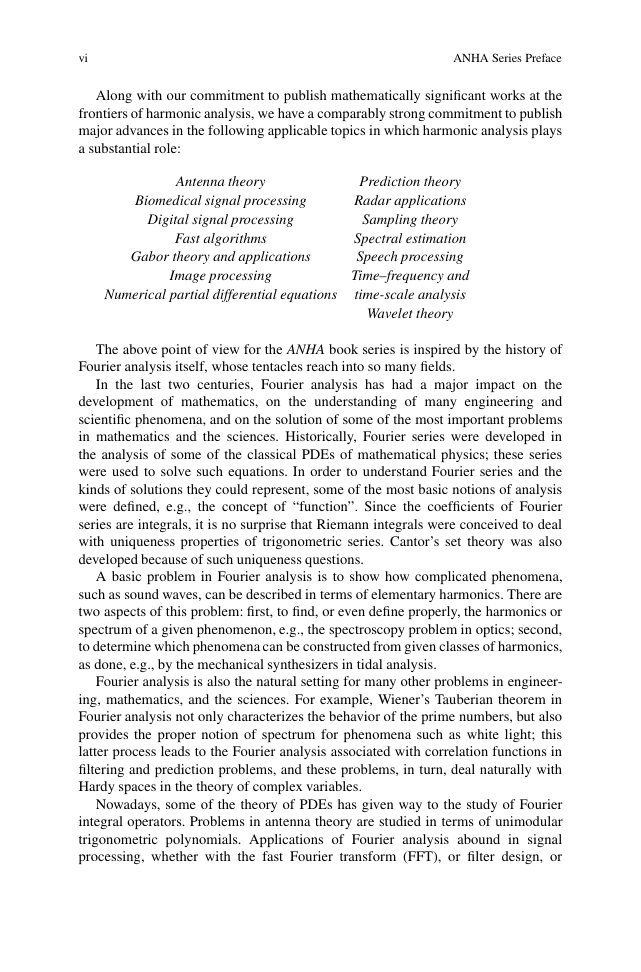ANHA Series Preface
Preface
Contents
Chapter
1 An Invitation to Compressive Sensing
1.1 What is Compressive Sensing?
1.2 Applications, Motivations, and Extensions
1.3 Overview of the Book
Notes
Chapter
2 Sparse Solutions of Underdetermined Systems
2.1 Sparsity and Compressibility
2.2 Minimal Number of Measurements
2.3 NP-Hardness of 0-Minimization
Notes
Exercises
Chapter
3 Basic Algorithms
3.1 Optimization Methods
3.2 Greedy Methods
3.3 Thresholding-Based Methods
Notes
Exercises
Chapter
4 Basis Pursuit
4.1 Null Space Property
4.2 Stability
4.3 Robustness
4.4 Recovery of Individual Vectors
4.5 The Projected Cross-Polytope
4.6 Low-Rank Matrix Recovery
Notes
Exercises
Chapter
5 Coherence
5.1 Definitions and Basic Properties
5.2 Matrices with Small Coherence
5.3 Analysis of Orthogonal Matching Pursuit
5.4 Analysis of Basis Pursuit
5.5 Analysis of Thresholding Algorithms
Notes
Exercises
Chapter
6 Restricted Isometry Property
6.1 Definitions and Basic Properties
6.2 Analysis of Basis Pursuit
6.3 Analysis of Thresholding Algorithms
6.4 Analysis of Greedy Algorithms
Notes
Exercises
Chapter
7 Basic Tools from Probability Theory
7.1 Essentials from Probability
7.2 Moments and Tails
7.3 Cramér's Theorem and Hoeffding's Inequality
7.4 Subgaussian Random Variables
7.5 Bernstein Inequalities
Notes
Exercises
Chapter
8 Advanced Tools from Probability Theory
8.1 Expectation of Norms of Gaussian Vectors
8.2 Rademacher Sums and Symmetrization
8.3 Khintchine Inequalities
8.4 Decoupling
8.5 Noncommutative Bernstein Inequality
8.6 Dudley's Inequality
8.7 Slepian's and Gordon's Lemmas
8.8 Concentration of Measure
8.9 Bernstein Inequality for Suprema of Empirical Processes
Notes
Exercises
Chapter
9 Sparse Recovery with Random Matrices
9.1 Restricted Isometry Property for Subgaussian Matrices
9.2 Nonuniform Recovery
9.3 Restricted Isometry Property for Gaussian Matrices
9.4 Null Space Property for Gaussian Matrices
9.5 Relation to Johnson–Lindenstrauss Embeddings
Notes
Exercises
Chapter 10 Gelfand Widths of ℓ1-Balls
10.1 Definitions and Relation to Compressive Sensing
10.2 Estimate for the Gelfand Widths of 1-Balls
10.3 Applications to the Geometry of Banach Spaces
Notes
Exercises
Chapter
11 Instance Optimality and Quotient Property
11.1 Uniform Instance Optimality
11.2 Robustness and Quotient Property
11.3 Quotient Property for Random Matrices
11.4 Nonuniform Instance Optimality
Notes
Exercises
Chapter
12 Random Sampling in Bounded Orthonormal Systems
12.1 Bounded Orthonormal Systems
12.2 Uncertainty Principles and Lower Bounds
12.3 Nonuniform Recovery: Random Sign Patterns
12.4 Nonuniform Recovery: Deterministic Sign Patterns
12.5 Restricted Isometry Property
12.6 Discrete Bounded Orthonormal Systems
12.7 Relation to the Λ1-Problem
Notes
Exercises
Chapter
13 Lossless Expanders in Compressive Sensing
13.1 Definitions and Basic Properties
13.2 Existence of Lossless Expanders
13.3 Analysis of Basis Pursuit
13.4 Analysis of an Iterative Thresholding Algorithm
13.5 Analysis of a Simple Sublinear-Time Algorithm
Notes
Exercises
Chapter
14 Recovery of Random Signals using Deterministic Matrices
14.1 Conditioning of Random Submatrices
14.2 Sparse Recovery via 1-Minimization
Notes
Exercises
Chapter 15 Algorithms for ℓ1-Minimization
15.1 The Homotopy Method
15.2 Chambolle and Pock's Primal-Dual Algorithm
15.3 Iteratively Reweighted Least Squares
Notes
Exercises
Appendix
A Matrix Analysis
A.1 Vector and Matrix Norms
A.2 The Singular Value Decomposition
A.3 Least Squares Problems
A.4 Vandermonde Matrices
A.5 Matrix Functions
Appendix
B Convex Analysis
B.1 Convex Sets
B.2 Convex Functions
B.3 The Convex Conjugate
B.4 The Subdifferential
B.5 Convex Optimization Problems
B.6 Matrix Convexity
Appendix
C Miscellanea
C.1 Fourier Analysis
C.2 Covering Numbers
C.3 The Gamma Function and Stirling's Formula
C.4 The Multinomial Theorem
C.5 Some Elementary Estimates
C.6 Estimates of Some Integrals
C.7 Hahn–Banach Theorems
C.8 Smoothing Lipschitz Functions
C.9 Weak and Distributional Derivatives
C.10 Differential Inequalities
List of Symbols
References
Applied and Numerical Harmonic Analysis (63 Volumes)
Index
















 2023年江西萍乡中考道德与法治真题及答案.doc
2023年江西萍乡中考道德与法治真题及答案.doc 2012年重庆南川中考生物真题及答案.doc
2012年重庆南川中考生物真题及答案.doc 2013年江西师范大学地理学综合及文艺理论基础考研真题.doc
2013年江西师范大学地理学综合及文艺理论基础考研真题.doc 2020年四川甘孜小升初语文真题及答案I卷.doc
2020年四川甘孜小升初语文真题及答案I卷.doc 2020年注册岩土工程师专业基础考试真题及答案.doc
2020年注册岩土工程师专业基础考试真题及答案.doc 2023-2024学年福建省厦门市九年级上学期数学月考试题及答案.doc
2023-2024学年福建省厦门市九年级上学期数学月考试题及答案.doc 2021-2022学年辽宁省沈阳市大东区九年级上学期语文期末试题及答案.doc
2021-2022学年辽宁省沈阳市大东区九年级上学期语文期末试题及答案.doc 2022-2023学年北京东城区初三第一学期物理期末试卷及答案.doc
2022-2023学年北京东城区初三第一学期物理期末试卷及答案.doc 2018上半年江西教师资格初中地理学科知识与教学能力真题及答案.doc
2018上半年江西教师资格初中地理学科知识与教学能力真题及答案.doc 2012年河北国家公务员申论考试真题及答案-省级.doc
2012年河北国家公务员申论考试真题及答案-省级.doc 2020-2021学年江苏省扬州市江都区邵樊片九年级上学期数学第一次质量检测试题及答案.doc
2020-2021学年江苏省扬州市江都区邵樊片九年级上学期数学第一次质量检测试题及答案.doc 2022下半年黑龙江教师资格证中学综合素质真题及答案.doc
2022下半年黑龙江教师资格证中学综合素质真题及答案.doc